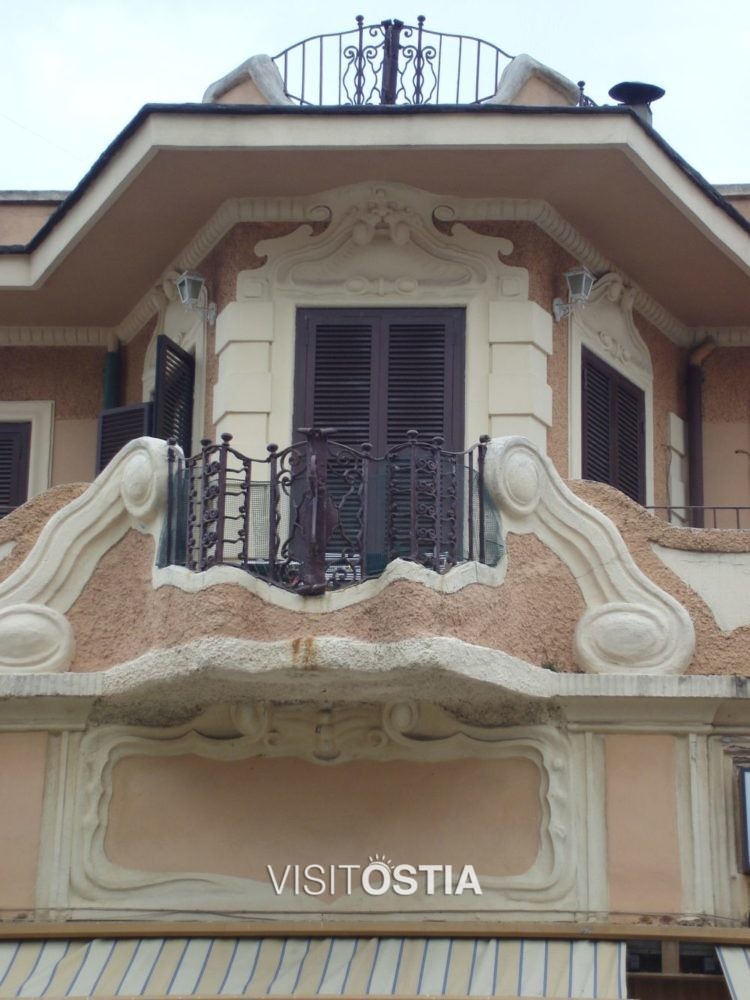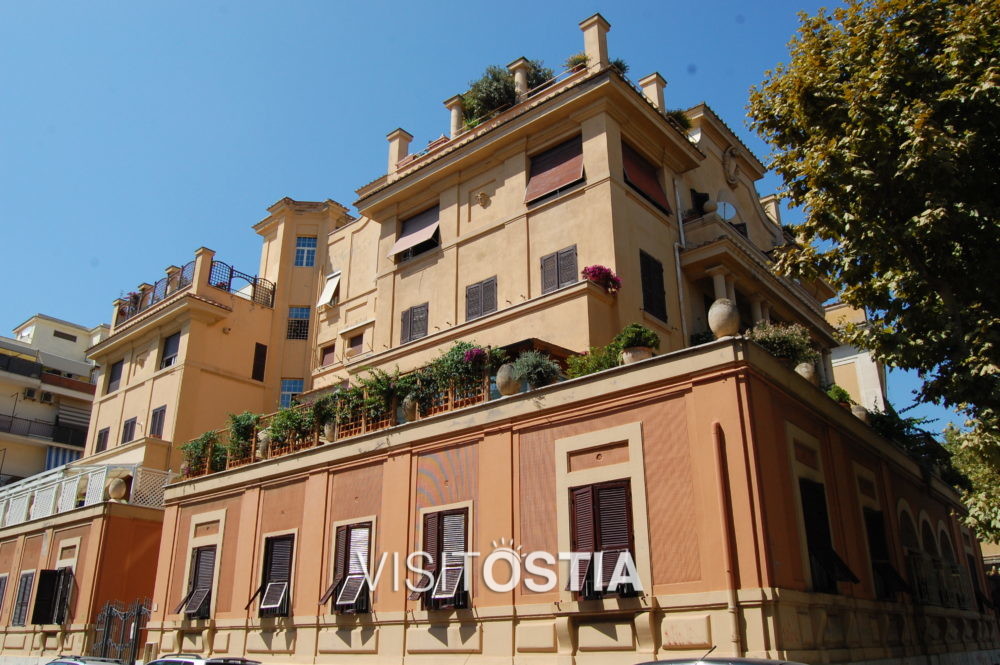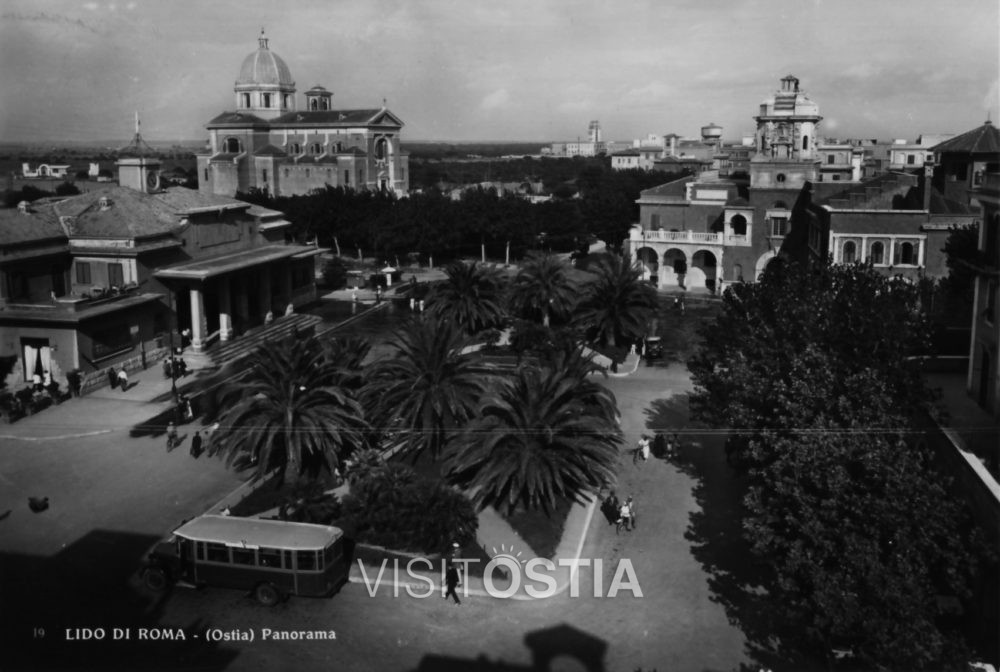This route includes the historic centre of Ostia. It starts from the square in front of the church of Santa Maria Regina Pacis, which is the symbol of the New Ostia risen back to life, since its foundation.
Going down the wide stairs in front of the church you arrive in Corso Regina Maria Pia. On the corner between this road and via Celli, are two buildings, designed by Enrico Vallini in 1929, together with a very young Luigi Moretti. They are an important example of a Roman architecture of transition, which moved from traditional designs towards designs more typical of the new modernist architecture.
Going on on the right is the fire brigade building. It is a rationalist building built in the 1030s by Giovannetti Building Co.
Until WWII together with the urban part of via del Mare, this part of the route which continues in via degli Acilii was the main axis of the city, perpendicular to the coast. The church was its internal head while the bathing resort Roma (which was completely destroyed in 1943 by the Germans) was the external head towards the Tyrrhenian.
Designed in 1922 by Giovan Battista Milani and unveiled on 10 th August 1924, Roma was composed by a ground floor building which perfectly replicated the thermal Roman frigidarium and by a two storey round element which was a mix of architectural designs: ancient Roman, gothic, byzantine and liberty. A long walkway joined the two elements. The inside was decorated with Pompeian elements by Antonio Calcagnodoro. What remains of the concrete pillars is still visible just under water level, near the beach of the bathing resort called Lido.
Via Celli intersects with piazza Giuliano della Rovere, where you can see modern buildings on the left. On the right you enter via dei Misenati, which on the left has a long series of buildings built in the 1920s. here begins the pedestrian area of Ostia, full of bars, restaurants, shops and pubs.
Via dei Misenati ends in piazza Anco Marzio.
This has always been the most important meeting point in Ostia: it still has its original atmosphere today surrounded by buildings from the 1920s. It is a large square, where you can have a cup of coffee, an ice cream, a drink, an aperitif, dinner or lunch.
The original 1916 name (in the City Plan of 1916) of this square was Grande Piazza Popolare. It has a great position which overlooks the sea. There is also a little garden in which you find a statue by Pietro Consagra dedicated to Pier Paolo Pasolini and put there in 1993.
Around this square you see some precious buildings designed in 1929 by Edmondo Del Bufalo. The two most interesting ones are those of the corner with the promenade.
On the left is Palazzo del Pappagallo, where there should have been a liberty grand hotel. On the right there are two twin villas built in the 1920s. their facades remind us of the late Roman Barocque style, with an addition of new medieval elements. Their main entrance is on the promenade. This crosses with via della Marina giving birth to piazza dei Ravennati, which is Ostia’s focal point thanks to il pontile (the pier).
Piazza dei Ravennati is closed by two buildings: the one on the right, built in 1929 by architect Mario Marchi, again expresses the passage from a rationalist architecture to a more modern one.
On the western part of viale della Marina is a small square from which starts via Lucio Coilio. This is not a straight road, because in 1916, the designers did not want to give this city a monotonous aspect.
It had to be a lively, green and relaxed seaside town. Along this road you can still admire buildings which are important for their aspect and functionality, being great examples of Ostia’s original layout.
Back to piazza Anco Marzio, turning right, you go along via della Stazione Vecchia where you find an interesting building designed in 1928 by Enrico Vallini and Luigi Moretti.
The entrance to this building is in via Santa Monica. The building reveals its late Roman baroque style with a mix of medieval and reinassance elements. Globally the aspect is eclectic. It uses details in an easy going way together with a rigorous composition. Also this represents a transitional element from a classic to a more modern architecture.
Via della Stazione Vecchia ends on a large square which today is shapeless. Originally it was an important urban space, with a coherent planning, which can be seen in old photos. The part which today is a parking space in front of the luna park, was the railway station of Ostia Lido. The terminus was destroyed in 1943 by the German troops together with its twin, the Piramide station in Rome, designed by Marcello Piacentini in 1920.
This square and its surroundings formed the Civic Centre of Ostia, as provided for in 1916’s city plan. It should have been Ostia’s forum. Luckily, even if the station disappeared, the seafront was maintained intact, with a building built over a grand hotel and west ward a housing complex enriched with many details which date it to the 1920s.
This urban space is dominated by the Town Hall, designed by Vincenzo Fasolo and built between 1924 and 1926.
Along corso Regina Maria Pia, you are again next to the stairs which take you up to Regina Pacis church.













